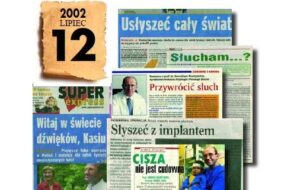The 16th anniversary of the first in the world cochlear implantation by Prof. Henryk Skarżyński in a partially deaf person

On the 12th July we will celebrate the 16th anniversary of the first in the world cochlear implantation by Prof. Henryk Skarżyński in a partially deaf person.
This was an opportunity to electrically complement normal hearing in the low frequency range up to 500 Hz. It was a subsequent stage of the program of preoperative residual hearing preservation started 5 years earlier. Thus, ten years after the first cochlear implantation in the deaf person in Poland, Prof. Henryk Skarżyński undertook to overcome another barrier, faced until then by doctors and partially deaf patients. The first such patient was a psychology student, which was very helpful for the specialists from Kajetany, because she understood perfectly what it meant and what the whole process was about. Without a proper attitude of the patient, a decision to perform such an operation would be difficult. Having done all the tests that could have been done at that time Prof. Skarżyński decided to attempt – the first such a surgery in the world– not only to perform it but mainly to show it to the world, via on-line transmission.
Let’s take a trip down memory lane and recall the press coverage. The late journalist Krzysztof Zbytniewski from the Super Express was one of those who recounted this operation. He described the surgery in an article entitled:
“Hear the whole world”: „11.00 am. The surgery begins. Marek – an architect, Kasia’s boyfriend awaits in the hall. He had been her interpreter, a link to the world outside. In the operating room – Kasia is asleep in a tangle of tubes, among beeping computers. A microscope over her head. Incision behind the ear. A fragment of her skull exposed. The hammering begins, in a moment, drills join in: first big ones. Drilling next to the facial nerve Prof. Skarżyński is now reaching the middle ear (where the whole auditory apparatus is located), the tiny drill head is smaller than a millimeter. The smallest mistake and everything in vain! That’s why I make every move holding my breath! – explains Professor. 11.40 am. There is a “window” – an entrance to the inner ear (cochlea). Like a dot at the end of this sentence. You have to insert through it an electrode with eight endings that will stimulate the auditory nerves. The Professor attaches the implant (size of a large button) to the skull underneath the skin (behind the ear), it will send micro-impulses to the cochlea. 12.40 pm – looking into the microscope the Professor inserts the electrode into the cochlea. Top precision job! After 2.5 hours the operation was over.“
In turn, the journalist – Iwona Konarska from the weekly Przegląd in an article entitled “Silence is not wonderful” described the events as follows:
“The surgery took place in July. Apart from being a medical sensation, it broke stereotypes. Until now it was thought that the residual hearing should not be interfered with. You have to enjoy what you have. Buy a hearing aid and live with a prosthesis. – I proved that implantation does not have to mean the destruction of the residual hearing. On the contrary, artificial hearing can perfectly complement the natural one. We’ve been presenting our research for two years, but the stereotype was so strong that nobody believed us – recalls Professor. (…) And now the “Polish way of” partial deafness treatment becomes a procedure applicable in the whole world. In December, articles would appear in the professional Western press, in the spring of 2003 an international commission would come to assess the results of the surgery. Great success.“
For 16 years of partial deafness treatment such press coverage has been abound. This breakthrough in the history of otosurgery was preceded by a presentation given by Prof. H. Skarżyński and his team at the 5th European Conference of Cochlear Implants in 2000 in Antwerp, and then at the European Congress of Otolaryngological Societies EUFOS in 2000 in Berlin, about the possibility of preserving residual hearing during implantation. This involved the use of an appropriate device system and the development of a new surgical method consisting of “6 steps”. This completely new method of partial hearing loss treatment, based on the preservation of existing preoperative normal hearing in the low frequency range in patients diagnosed with partial deafness and the first in the world classification were named after Skarżyński.